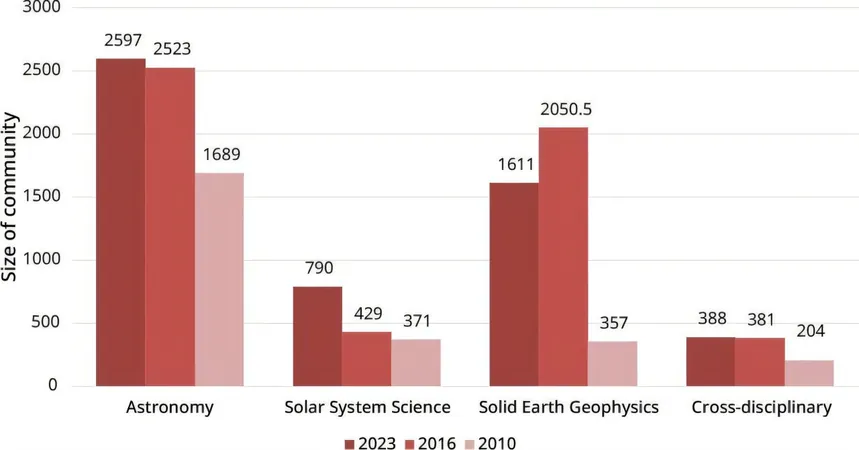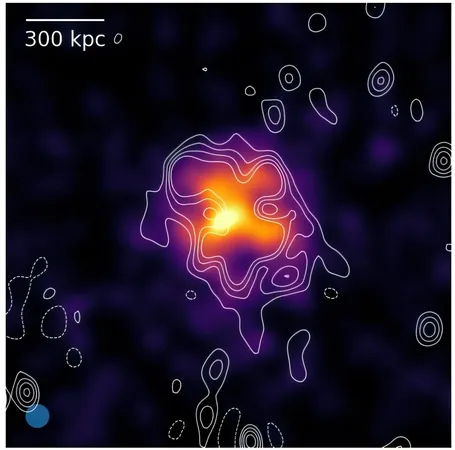
Astronomy and Geophysics: A Wake-Up Call on Diversity Issues
2025-07-10
Author: Nur
A Stark Reality in Science
Despite numerous initiatives aimed at fostering inclusivity over the past decade, a recent survey has unveiled a disappointing truth: women and ethnic minority groups remain vastly underrepresented in the fields of astronomy and geophysics.
Survey Findings
Conducted by the Royal Astronomical Society and presented at the National Astronomy Meeting (NAM 2025) in Durham, the 2023 survey highlighted that the demographic landscape has barely shifted. "Practitioners of astronomy and geophysics are still overwhelmingly white men," it stated, underlining a stubbornly low proportion of women in these science domains.
A Call for Change
Professor Mike Lockwood, President of the Royal Astronomical Society, expressed concern over the missed opportunities for harnessing talent from diverse backgrounds. He remarked, "Our sciences are missing out on some of the best talent available," stressing the need for a more equitable environment. "Until we achieve a perfect meritocracy, the loss of talent will persist."
Stark Statistics
The survey revealed that a staggering 97% of British respondents in these fields were white, a slight increase from 95% in 2016. This contrasts sharply with census data that shows 83% of the overall U.K. population identifies as white.
Furthermore, among postgraduate students, 92% of British respondents were white. When examining undergraduate placements in astronomy, the data indicate that 83% of acceptances went to white applicants—a troubling sign of a lack of diversity in educational pathways.
Gender Discrepancies in Academia
While there has been a positive trend in the increase of women in senior academic roles in astronomy and solar system sciences since 2010, the numbers for lecturers have stagnated, and have even decreased in solid-Earth geophysics, dropping to just 19%.
Underrepresentation of Gender and Sexual Diversity
Interestingly, representation is slightly better among postdoctoral researchers, with women making up 28% in astronomy. However, the survey also revealed that non-binary respondents accounted for only 3% of permanent staff.
On the topic of sexual orientation, the academic community in astronomy and geophysics appears to be more diverse than the general population, with 3% identifying as gay or lesbian and 14% of postdoctoral researchers identifying as bisexual.
A Road Ahead for Inclusivity
Dr. Robert Massey, deputy executive director of the Royal Astronomical Society, emphasized the importance of fostering curiosity about our universe in children from all walks of life. He urged that everyone should have the opportunity to pursue careers in science, stating, "We need to see far more women and people from minority ethnic groups in roles as astronomers and geophysicists. Our commitment to making that happen must be stronger than ever."




 Brasil (PT)
Brasil (PT)
 Canada (EN)
Canada (EN)
 Chile (ES)
Chile (ES)
 Česko (CS)
Česko (CS)
 대한민국 (KO)
대한민국 (KO)
 España (ES)
España (ES)
 France (FR)
France (FR)
 Hong Kong (EN)
Hong Kong (EN)
 Italia (IT)
Italia (IT)
 日本 (JA)
日本 (JA)
 Magyarország (HU)
Magyarország (HU)
 Norge (NO)
Norge (NO)
 Polska (PL)
Polska (PL)
 Schweiz (DE)
Schweiz (DE)
 Singapore (EN)
Singapore (EN)
 Sverige (SV)
Sverige (SV)
 Suomi (FI)
Suomi (FI)
 Türkiye (TR)
Türkiye (TR)
 الإمارات العربية المتحدة (AR)
الإمارات العربية المتحدة (AR)